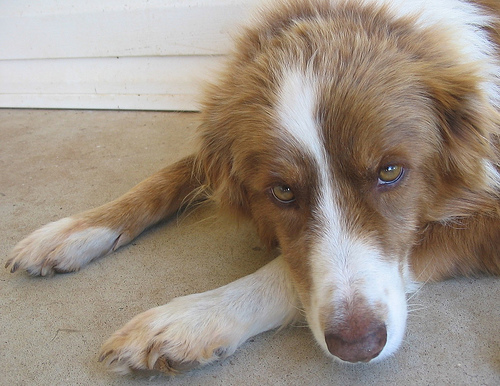
Acquired hypothyroidism is the most common endocrine disease of dogs, although it rarely occurs in cats. The onset of hypothyroidism is gradual, and many dogs will suffer for years before they are diagnosed.
What is hypothyroidism?
The thyroid gland produces hormones that regulate the body’s metabolism. Hypothyroidism is caused by a deficiency of the thyroid hormones T3 and T4, which results in the metabolism gradually slowing down. There are two types of hypothyroidism: congenital and acquired.
Congenital hypothyroidism is an uncommon disease that results in cretinism. Acquired hypothyroidism makes up about 95% of hypothyroid cases. In dogs with acquired hypothyroidism, there is progressive destruction of the thyroid gland. Signs of disease start when more than 75% of the thyroid gland has been destroyed.
Are certain breeds more susceptible to disease?
Any breed can develop hypothyroidism; however, certain breeds appear to be over-represented. Breed predilections have been reported in the Boxers, Cocker Spaniels, Dachshund, Doberman Pinscher, Golden Retriever, Great Dane, Irish Setter, Miniature Schnauzer, Old English Sheepdog, Poodle, and Shetland Sheepdogs. Dogs are typically middle-aged when they first show signs of disease, usually between the ages of 4 and 10 years old.
What are the signs of hypothyroidism?
As the thyroid hormones in the body decrease, the dog’s metabolism will slow down and signs will appear that may initially be attributed to the ageing process. The symptoms are extremely variable and may include any of the following:
• Lethargy
• Mental depression
• Inability or unwillingness to exercise
• Weight gain (without an increase in appetite)
• Drowsiness
• Cold intolerance (e.g. avoids cold floors)
• Gradual hair loss (patchy or bilaterally symmetrical)
• Dry hair coat or excessive shedding
• Skin disease (e.g. comedones, excessive pigmentation, thickening, scaling, bacterial infections, poor wound healing, etc.)
• Reproductive changes (e.g. decreased libido, infertility, irregular oestrus cycles)
• Drooping eyelids
• Neuromuscular problems (e.g. stiff gait and weakness)
• Gastrointestinal problems – constipation, vomiting, diarrhoea (uncommon)
If you suspect your dog has hypothyroidism, make an appointment with a veterinarian. Hypothyroidism is a treatable disease.
How is hypothyroidism diagnosed?
A veterinarian will take a history, perform a thorough physical exam, and collect blood and urine samples. The diagnosis is confirmed by measuring the levels of thyroid hormone in the blood. There are a number of tests that measure thyroid hormones in the blood, and it may be necessary to perform more than one to confirm a diagnosis.
How is hypothyroidism treated?
Treatment of hypothyroidism is fairly straightforward. Thyroxine sodium (Soloxine), a synthetic thyroid hormone, is the drug therapy of choice. Hormone supplementation with thyroxine is required for the rest of the dog’s life. Dosages will vary, and must be tailored for individual patients. Frequent checks are often required to ensure that the thyroid hormone concentrations in the bloodstream are at the correct level.
What happens if I overdose my dog on thyroxine?
Overdosing dogs with thyroxine is very uncommon. Signs of overdosage are restlessness, panting, diarrhoea, increased consumption of water, and urinating excessively. If your dog is showing these signs, contact your veterinarian.
What is the prognosis for a dog diagnosed with hypothyroidism?
The prognosis for dogs that are on thyroid hormone replacement therapy is quite good. Most dogs will achieve a normal life expectancy, although they will be on thyroxine for the rest of their lives.
(photo: joshme17)